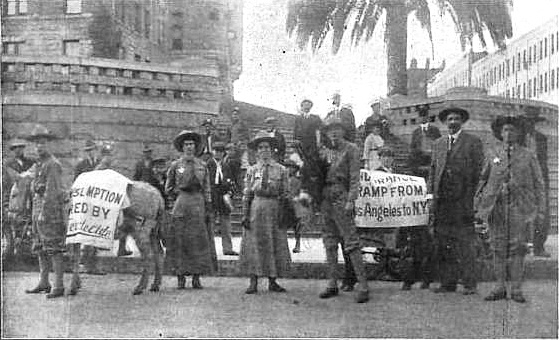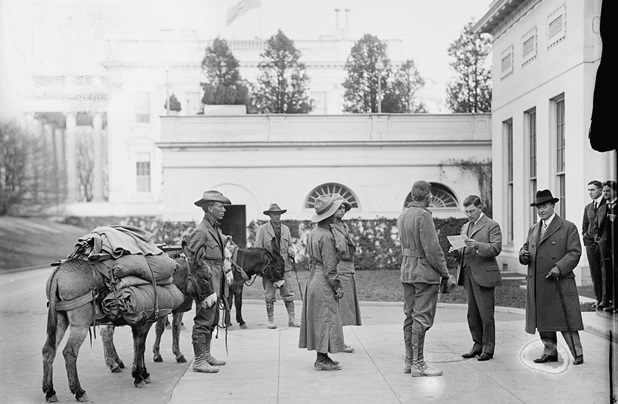Among postcard collectors who specialize in social history, the genre of card you see here is known as a “walker.” “Walkers” are comparatively rare and frequently are real-photo cards. The image is usually of an individual, but sometimes a group, and the message tells the reason the walking was done and mentions the starting point and intended finish line.

This card heralds the efforts of four people who began their “walk” in April 1913, but an additional cast of characters includes a Los Angeles doctor, a President of the United States, and some of the many who want to believe everything they read in the newspapers.
The story begins on February 16, 1911, when Alfred A. Berger (far right in the photo), of Riverside, California, wrote a testimonial letter to the Tuberclecide Company at the International Bank Building in Los Angeles. In his letter he tells of his battles with tuberculosis, including his hemorrhages, skyrocketing body temperatures, and his excessive weight-loss.
Then he explains how, after only five months of treatment using a product called “Tuberclecide,” he is regaining his lost weight and is once again able to breathe well enough to live a normal life. He ends with “[I am] a man amongst men once more.”
Six months later, on August 16, 1911, in the Los Angeles Times published a story under the headline “Proofs That Tuberclecide Cures Consumption” and Mr. Berger’s letter appeared in a display advertisement along with similar letters from Francis Marshall Elliot, Mary B. Harper, and Mrs. John Bassett.
For the next several months the news of Tuberclecide raged like the Santa Ana winds. All around the hospitals and tuberculosis sanitariums and generally throughout the medical community of southern California, words and phrases like “amazing,” “miracle,” and “recommended by leading lung specialists of Europe” were used to convince tubercular patients that cures were available.
Who originated the idea for the cross-country walk is unknown, but there is text on the back of this real-photo card that includes the date (April 8, 1913), the names of the participants — Carrie Van Gaasbeek, Mabel Clarkson Ackerman, N. A. Clarkson, J. T. Price and Al Berger, and this text: “Tuberclecide Endurance Tramp, Los Angeles to New York.”
The only other evidence we have found in newspapers is of a telegram sent to the editor of the Los Angeles Times from El Paso, Texas, on June 14, 1913. In part it reads: “Three men, two women and three burros arrived here on the first leg of an ocean-to-ocean hike from Los Angeles to New York. The hikers . . . who were cured in Los Angeles of tuberculosis are walking to New York to prove it. They hope to reach New York by Thanksgiving.”

And the rest of the story is . . . after a stop in Washington, D. C., where they had their photograph taken at the White House and urged President Woodrow Wilson to persuade the National Health Service to provide funds for anyone who could not afford treatment to receive the medication free-of-charge, the walkers moved on and arrived in New York City on December 31, 1913.
